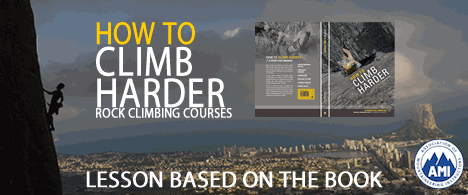The two most common types of foothold we use when looking at our footwork are edges and smears. ‘Edging’ is standing on a small edge or a tiny ledge. ‘Smearing’ is when the rock is featureless so we smear as much of the surface of our boot against the rock as possible and use the friction of the boot rubber to hold our foot in place.
Smearing and edging exercise
On a small and very gently inclined boulder, stand on an edge and then on a smear. Then experiment with different parts of the boot. Inside and outside edges, heel and the toe.
Try using smaller edges and poorer smears on steeper rock. What is the limit of the rock type you are on? Are other rock types different if so, how? Which is easier smearing or edging? Which is easier inside/outside edge, heel or toe? Could you put them in order of strain on the calf muscles? Over time you will you will build up the foot strength to stand on smaller and smaller edges, as well as an appreciation of what is possible on different rock types.
Now climb up a gently inclined boulder trying to utilise first edges, then smears and finally both in ascent and descent.
Edging tips – Don’t drop the heel. Try and keep the ankle at 90 de- grees.
Smearing tips – Drop the heel. Try and get as much rubber on the base of the foot in contact as pos- sible.
Moving up
Now you have gotten to grips with the basic foothold, we need to start putting the footwork together by linking a few moves. The emphasis is on your feet doing most of the work here. So use easy slabs and try and climb one or no handed.
Moving up – exercise 1
Walk up a gently inclined boulder taking first giant steps and then tiny steps. Which feels the easiest?
Moving up – exercise 2
On easy terrain try facing directly up the slab and climbing up and then try facing only right and then only left, at times it will feel quite un- natural as you have to backstep. After that try to link facing left and right by almost walking up in a series of zigzags pivoting around at the end of each zig. During this exercise you will need to stand on the inside edge of one foot and the outside of the other. Which one required less effort from your leg muscles?
Being side-on, we instantly reduce the leverage on the calf muscle by reduc- ing the distance between the heel and the point of contact. Also our centre of gravity also comes into the wall reducing the weight on our arms.
By the end of these exercises you will have realised that as well as edging rock boots can also smear, although on steeper rock this becomes more difficult; that giant steps are less efficient than small ones; and that being side-on is less strenuous on your calves and more stable.
Moving up – exercise 3
Just like the previous exercise, although this time on a easy slab climb that requires you to use your hands for balance. Face right so that you are looking along the wall, and climb the route maintaining the side on profile. You will be forced to back step onto holds. Repeat again but face left.
Now climb the same route, again facing sideways, but this time really con- centrate on facing one way and simply walking forwards up the climb until you run out of foot holds and then pivot round to face the other direction. Effectively zigzagging up the route.
To progress this still further don’t allow the outside arm to touch the rock, pretend you are taking a phone call and as you pivot round change which ear you are listen to the phone on. Rely entirely on the inside arm for balance. This will put you in a more natural body position, and whilst at first it may seem more difficult it will help you adopt positions of balance in between the movement so you can then move the hand.
This can be progressed further still on many easier slabs to either no handed or just using the palm of your hand for balance.
Side on tips
Concentrate on facing at 90 ̊ to the rock face.
You will almost be walking up the slab.
Find a point of balance in between moving and stop, use this to move your hands.
At times you will need to backstep.
